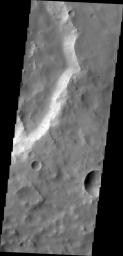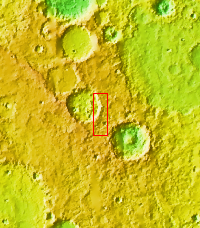
|
Dark Slope Streaks
- Click the image above for a larger view
- Full-Res JPEG (1326 x 2770) (205.3 kB)
- Full-Res TIFF (1326 x 2770) (3.7 MB)
Caption:
Dark slope streaks, like the ones on the rim of a unnamed crater in Terra Sabaea, are thought to have been formed by material moving down slope due to gravity. As the lighter toned fine materials are removed, the darker toned underlying materials are exposed.
Orbit Number: 36989 Latitude: 9.14607 Longitude: 28.0491 Instrument: VIS Captured: 2010-04-17 00:33
Background Info:
Please see the THEMIS Data Citation Note for details on crediting THEMIS images.
NASA's Jet Propulsion Laboratory manages the 2001 Mars Odyssey mission for NASA's Science Mission Directorate, Washington, D.C. The Thermal Emission Imaging System (THEMIS) was developed by Arizona State University, Tempe, in collaboration with Raytheon Santa Barbara Remote Sensing. The THEMIS investigation is led by Dr. Philip Christensen at Arizona State University. Lockheed Martin Astronautics, Denver, is the prime contractor for the Odyssey project, and developed and built the orbiter. Mission operations are conducted jointly from Lockheed Martin and from JPL, a division of the California Institute of Technology in Pasadena.
Cataloging Keywords:
| Name | Value | Additional Values |
|---|---|---|
| Target | Mars | |
| System | ||
| Target Type | Planet | |
| Mission | 2001 Mars Odyssey | |
| Instrument Host | Mars Odyssey | |
| Host Type | Orbiter | |
| Instrument | Thermal Emission Imaging System (THEMIS) | |
| Detector | ||
| Extra Keywords | Crater, Grayscale, Thermal | |
| Acquisition Date | ||
| Release Date | 2010-06-16 | |
| Date in Caption | 2010-04-17 | |
| Image Credit | NASA/JPL/ASU | |
| Source | photojournal.jpl.nasa.gov/catalog/PIA13206 | |
| Identifier | PIA13206 | |

